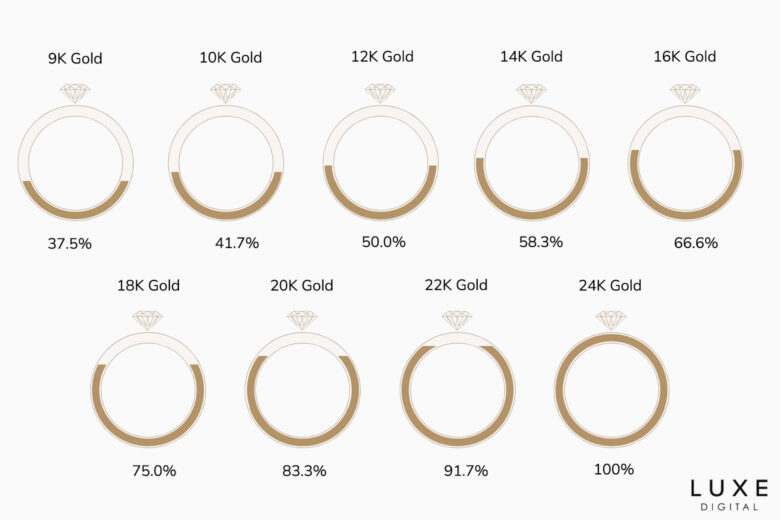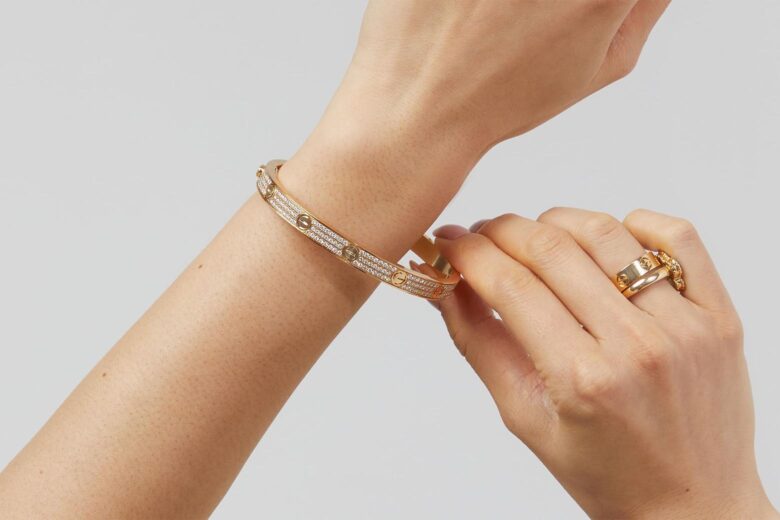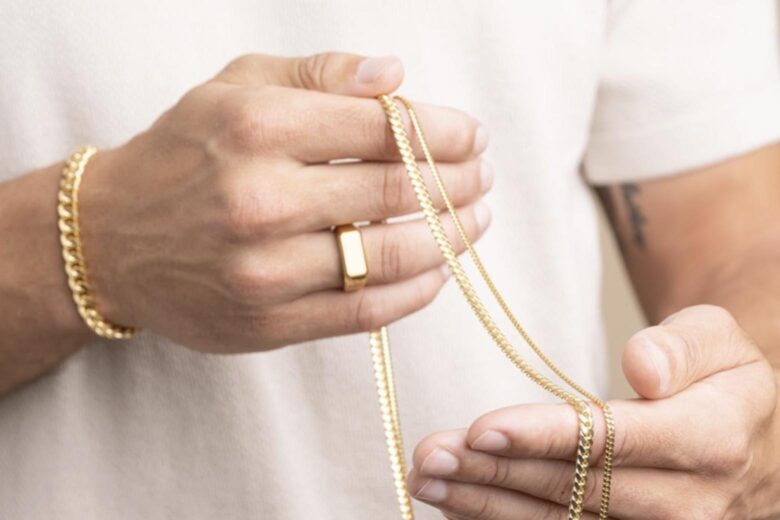We all know that gold is highly valuable. However, when it comes to gold jewelry, the type of gold used has an enormous impact on the value of the piece.
It may be worth its weight in gold—but what kind of gold is the real question.
Wait, doesn’t all real gold have the same value? Pure gold does. But pure gold is usually considered too soft to work with. And so most solid gold jewelry is made from karat gold. What exactly is karat gold? You’ve hit the goldmine (pun intended). After digging deep into understanding gold purity, here we have the gold karat explained.
Karat gold: Understanding gold purity
Karat is the measure of the purity of gold, with pure gold being 24 karats. However, 24 karat gold jewelry is not considered strong enough for everyday wear. Therefore most real gold jewelry is made from lower karat gold. Although karat gold is alloyed with a different ratio of other metals, it is still considered solid gold because the alloy is consistent throughout, meaning there is no other base metal.
Most of us know that the higher the karat, the more expensive it will be. This is simply because a higher karat means a greater percentage of gold.
Because of its scarcity and natural beauty, gold is a valuable resource. But an alloy with more gold isn’t necessarily better. Gold alloys are created by mixing other metals with pure gold to create a stronger version of itself. Therefore, the lower the karatage, the stronger it will be.
It’s always a balance though, because higher karat gold is more valuable, less susceptible to tarnishing, more hypoallergenic and has a richer yellow hue.
The number of karats represents the ratio of gold to other metals in an alloy. Pure gold is 24K gold, so one karat is one part of 24. This means that 18K gold is 18 parts pure gold and 6 parts other metals. And therefore, it is 75% gold and 25% other metals.
This sounds simple enough, but it can get pretty confusing when different countries start to use different spellings. Outside of the United States, “karat” is usually spelled “carat”. Although this is the same spelling used to measure the weight of diamonds and gemstones (see our article about the 4Cs of diamonds), the two should not be confused.

Main types of gold karats
It may be solid gold. But not all real gold jewelry is created equal. There are many different types of gold—each with a unique value.
24K Gold
24K Gold is pure gold. Even though it is called pure gold, 100% purity is unattainable, therefore “pure gold” refers to gold that is between 99.7% and 99.9% gold. Also known as fine gold, pure gold hasn’t been made stronger with other metals, therefore it maintains its rich yellow hue and is a lot softer than other types of gold. Because of this (and because it is so expensive), 24 karat gold jewelry is very rare in the United States. It is, however, a lot more popular in China, India and other Asian countries—especially for investment purposes.
| Appearance: | Extremely bright yellow |
| Common uses: I | Investments |
| Price: | $63 per gram |
22K Gold
22K Gold has 22 parts pure gold and 2 parts other metals such as silver, nickel and zinc. Because 22K solid gold is 92% pure gold, it is still a very bright yellow hue. And because it only has 8% other metals to make it stronger, it is still considered too soft to use for everyday pieces by most of the best jewelry brands in the United States.
So when is it used? Popular in South East Asia and the Middle East, 22K gold is used for family heirlooms and for delicate pieces that are worn on special occasions.
| Appearance: | Very bright yellow |
| Common uses: I | Family heirlooms and occasionwear |
| Price: | $58 per gram |
20K Gold
If you adore the bright yellow hue of pure gold, but require something a little stronger, 20K is a stellar choice. 20 parts pure gold and 4 parts other metals, 20K gold is still extremely valuable, making it a good investment.
However, 20K gold only contains 17% other metals, so it will not be as strong as other gold alloys. Therefore, it is not recommended for setting precious stones or for jewelry that receives a lot of contact with other surfaces. Instead, 20K is best used for simple, low-contact pieces such as high-quality earrings.
| Appearance: | Bright yellow |
| Common uses: I | Family heirlooms and occasionwear |
| Price: | $53 per gram |
18K Gold
Considered the holy grail of karat gold, 18K gold is the most popular type of gold used for solid gold jewelry in the United States. Made from 75% pure gold and 25% other alloys, 18K hits the elusive sweet spot between affluence and strength, making it the go-to choice for high-quality, fine jewelry. It is also considered durable enough to set precious stones and is commonly used for engagement rings and high-end watches.
Because it contains three times more gold than other metals, it is still a rich yellow hue, although not as bright as pure gold. The perfect combination for the most expensive Rolex watches, for example.
| Appearance: | Rich yellow |
| Common uses: I | Fine jewelry and engagement rings |
| Price: | $47 per gram |
16K Gold
Exactly two thirds pure gold and one third other metals, 16K is still mostly made up of gold. And whilst 16K gold isn’t a bad choice for balancing durability with the amount of gold, it is not frequently found in new jewelry stores. This is probably because modern buyers either opt for the opulence of 18K or the affordability and durability of 14K gold. It was, however, popular in the Victorian era and can still be found at many vintage jewelry stores.
| Appearance: | Rich yellow |
| Common uses: I | Vintage jewelry |
| Price: | $42 per gram |

14K Gold
Used to create some of our best necklaces and bracelets for women, 14K gold is still considered high quality gold jewelry—albeit a lot more affordable.
Made up of 14 part pure gold and 10 parts other metals, pure gold still comprises the majority of the alloy, while the high portion of strengthening metals makes it a lot more durable and scratch resistant than 18K gold. Commonly used in the United States and the United Kingdom, 14K gold is perfect for high-contact everyday pieces. And whilst the yellow hue is slightly less saturated than 18K gold, it is actually preferred by many.
| Appearance: | Less saturated rich yellow |
| Common uses: I | Everyday fine jewelry |
| Price: | $37 per gram |
12K Gold
12K Gold is half pure gold and half other metals. Although it is more affordable and more durable than 14K gold, it is not popular in most countries. This is likely because it contains too little gold to be considered “fine jewelry” but is still more expensive than 10K gold and 9K gold. Made up of 50% strengthening metals, 12K gold is thought to be too hard for wedding and engagement rings or more intricate pieces. Instead, it is best used for simple chains that require the added strength.
| Appearance: | More pale yellow |
| Common uses: I | Simple necklaces and chains |
| Price: | $32 per gram |
10K Gold
In order to be marketed as real gold in the United States, gold jewelry must be 10K or more. Made up of only 10 parts pure gold and 14 parts other alloys, 10K gold is made up of more alloys than it is pure gold. This makes it incredibly strong and durable, albeit a lot less valuable.
Because other metals make up the majority of the alloy, it has a pale yellow hue that is much less saturated than golds with higher karatages. As the most affordable type of gold in the U.S., it is very rarely used for fine jewelry and is too hard for setting stones.
| Appearance: | Pale yellow |
| Common uses: I | More affordable earrings |
| Price: | $26 per gram |
9K Gold
9K may not be considered to be real gold in the United States, but it is in other parts of the world. As the lowest permitted solid gold purity in the UK and Europe, 9K gold is only 9 parts pure gold and 15 parts other metals.
The upside of 9K gold is that it is almost impossible to scratch and is half the price of 18K. The downside is that the yellow hue is a lot more dull and the other metals may cause allergic reactions. It is also a lot less valuable and 9K gold is seldom used for fine jewelry or sentimental family heirlooms.
| Appearance: | Less saturated pale yellow |
| Common uses: I | Low-cost, hard wearing jewelry |
| Price: | $24 per gram |
Millesimal fineness
What does 585 mean on jewelry? Any three digit gold identification marks on jewelry usually refer to the millesimal fineness of the gold. This is just a more precise way to measure gold purity.
Millesimal fineness expresses the purity of gold in parts of 1,000. Put simply: if an alloy was divided into 1,000 parts, how many of them would be pure gold.
For example, 18K gold is 75% pure gold so it has a millesimal fineness of 750 and 14K gold is 58.33% gold so it has a millesimal fineness of 583.3 Techincally 24K gold should have a millesimal fineness of 1,000, but because it is impossible to attain 100% pure gold, it can only be refined to 99.9%, making its millesimal fineness 999.9.

Gold Karat Chart
From 24K to 9K, the gold karat scale reflects a range of gold purity and fineness.
| Karat | Parts Gold | Gold Purity | Gold Fineness |
| 24K | 24/24 | 99.9% | 999.7 to 999.9 |
| 22K | 22/24 | 91.7% | 916 to 917 |
| 20K | 20/24 | 83.3% | 832 to 834 |
| 18K | 18/24 | 75% | 750 |
| 16K | 16/24 | 66.7% | 666 to 667 |
| 14K | 14/24 | 58.3% | 583 to 585 |
| 12K | 12/24 | 50% | 500 |
| 10K | 10/24 | 41.7% | 416 to 417 |
| 9K | 9/24 | 37.5% | 375 |
Gold Hallmarks: Gold identification marks on jewelry
How to tell if gold is real? Be sure to check the hallmarks on a jewelry piece before adding it to your favorite jewelry organizer. Hallmarks refer to the small symbols stamped on jewelry to indicate the purity of the gold. These can vary from one country to the next, but essentially they all say the same thing.
Most European countries use millennial fineness to define gold purity. For example, 14K gold is 58.3% gold so the hallmark stamp would be 583. This is different to the United States and the United Kingdom. These countries typically indicate gold purity by karat, in which case the hallmark stamp would simply be 14K.
Check also our guides on the different types of gold to learn more about what to expect when shopping for gold jewelry:
We also have a dedicated series comparing the different colors of gold:
Frequently asked questions about gold karats
Although 24K gold is the purest and most expensive form of gold on the gold karat scale, it isn’t necessarily the best. Pure gold is often considered too soft for everyday jewelry. Therefore most jewelry brands use karat gold that has been strengthened with other metals. Made up of 75% pure gold and 25% other metals, 18K gold is usually considered the best for fine jewelry.
24K gold is also known as pure gold or fine gold, meaning that it contains no other metals. Whilst this makes it the most valuable form of gold, it also makes it the least durable form of gold, as other metals are usually added to solid gold jewelry to make it stronger. 24 karat gold jewelry can be a good investment, but we wouldn’t recommend wearing it everyday.
Almost all real gold jewelry is made from karat gold. Karat gold refers to pure gold that has been mixed with other alloys to make it stronger. In the United States, 18K gold is most commonly for highly valuable fine jewelry. While 14K is more affordable and more durable, making it a popular choice for everyday use.
While 24K gold is the purest form of gold, it doesn’t necessarily last the longest. This is because pure gold is actually quite soft and therefore other metals are usually added to it for strength. For the best quality gold jewelry that is also durable and scratch resistent, we recommend 14K gold or 18K gold.











